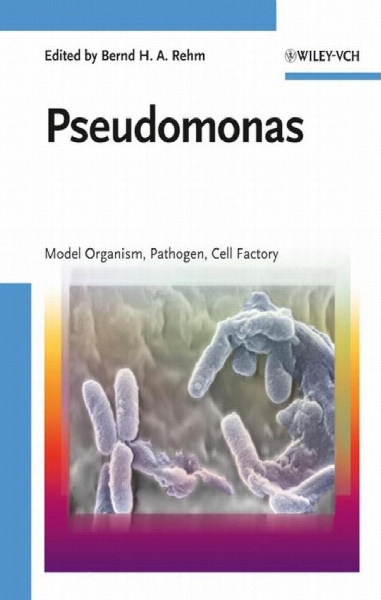Pseudomonas : model organism, pathogen, cell factory
- نوع فایل : کتاب
- زبان : انگلیسی
- مؤلف : Bernd H A Rehm
- ناشر : Weinheim : Wiley-VCH-Verl
- چاپ و سال / کشور: 2008
- شابک / ISBN : 9783527319145
Description
Preface. List of Contributors. 1 Comparative Genomics of Pseudomonas (Kristoffer Kiil, Tim T. Binnewies, Hanni Willenbrock, Susse Kirkelund Hansen, Lei Yang, Lars Jelsbak, David W. Ussery, and Carsten Friis) 1.1 Introduction. 1.2 Pan/Core Genome of Pseudomonas. 1.3 Phylogeny of Pseudomonas. 1.4 Blast Atlas of Pseudomonas Genomes. 1.5 Functional Categories. 1.6 Codon Usage and Expression. 1.7 Future Outlook. References. 2 Clinical Relevance of Pseudomonas aeruginosa: A Master of Adaptation and Survival Strategies (Niels Hoiby, Helle Krogh Johansen, Claus Moser, and Oana Ciofu). 2.1 Introduction. 2.2 CF. 2.3 Survival of P. aeruginosa by Adaptation to the Inflammatory Defense System. 2.4 Conductive and the Respiratory Zones of the Lungs. 2.5 Survival of P. aeruginosa by Adaptation to the Respiratory Zone of the Lungs. 2.6 Survival of P. aeruginosa by Adaptation to the Conductive Zone of the Lungs. 2.7 Survival of P. aeruginosa by Adaptation to the Antibiotic Therapy. 2.8 Evolutionary Implications of the Adaptability of P. aeruginosa. References. 3 Adherence of Pseudomonas aeruginosa (Randall T. Irvin). 3.1 Introduction. 3.2 What is Adherence? 3.3 Role of Adherence in Infection. 3.4 How is Bacterial Adherence Associated with Virulence? 3.5 P. aeruginosa Adhesins. 3.6 Surface Receptor Requirements of the Pilus Adhesin. 3.7 How Does PilA Mediate Attachment to Human Mucosal Surfaces? 3.8 X-ray Crystallographic Structural Studies of the Pilin Structural Protein. 3.9 Structure of the Pilus Fiber. 3.10 Structure of the Receptor-Binding Domain and Location on the Pilus. 3.11 Structural Nature of the Receptor-Binding Domain. 3.12 Twitching Motility. 3.13 How Does the Pilus Attach to a Solid Surface? 3.14 The Monkey-Bar Swing Paradox. 3.15 Molecular Basis for Receptor-binding Domain Interaction with Steel Surfaces. 3.16 Pili as Nanowires for Redox Reactions. 3.17 What is the Most Important Role of Adherence to P. aeruginosa. References. 4 Flagella and Pili of Pseudomonas aeruginosa (Jeevan Jyot and Reuben Ramphal). 4.1 Introduction. 4.2 Flagellum of P. aeruginosa. 4.3 Pili of P. aeruginosa. 4.4 Conclusions. References. 5 Pseudomonas Motility and Chemotaxis (Junichi Kato). 5.1 Introduction. 5.2 Chemotaxis Assay Methods. 5.3 Ecological Aspects of Chemotaxis. 5.4 Molecular Biology of Chemotaxis in Pseudomonas. 5.5 Pseudomonas as Model Microorganisms for Chemotaxis Research. References. 6 Iron Transport and Signaling in Pseudomonads (Francesco Imperi, Karla A. Mettrick, Matt Shirley, Federica Tiburzi, Richard C. Draper, Paolo Visca and Iain L. Lamont). 6.1 Introduction. 6.2 Siderophores Used by Pseudomonads. 6.3 Siderophore Synthesis. 6.4 Ferri-Siderophore Transport. 6.5 Regulation of Siderophore Synthesis and Transport. 6.6 Introduction to Signaling. 6.7 Concluding Remarks and Future Perspectives. References. 7 Quorum Sensing in Pseudomonads (S.P. Diggle, S. Heeb, J.F. Dubern, M.P. Fletcher, S.A. Crusz, P. Williams, and M. Camara). 7.1 Introduction to Quorum Sensing. 7.2 AHL QS in Pseudomonas aeruginosa. 7.3 AHL-Dependent QS in Other Pseudomonads. 7.4 AHQ-Dependent QS in Pseudomonads. 7.5 Gac/Rsm System in Pseudomonads. 7.6 QS and Infection. 7.7 Conclusions. References. 8 Regulatory Networks in Pseudomonas aeruginosa: Role of Cyclic-di(30,50)-Guanylic Acid (Ute Romling and Susanne Haussler). 8.1 Introduction - The History of Cyclic-di(30,50)-Guanylic Acid Detection. 8.2 Principles of c-di-GMP Signaling. 8.3 GGDEF and EAL Domain Proteins in P. aeruginosa. 8.4 c-di-GMP Signaling in Biofilm Formation. 8.5 c-di-GMP Signaling in Fimbrial Biogenesis. 8.6 c-di-GMP Signaling in Exopolysaccharide Production. 8.7 c-di-GMP Signaling and Motility. 8.8 c-di-GMP Signaling in the Formation of Small Colony Variants. 8.9 c-di-GMP Signaling in Virulence. 8.10 c-di-GMP-Binding Proteins in P. aeruginosa. 8.11 Perspectives. References. 9 Pseudomonas aeruginosa: A Model for Biofilm Formation (Diane McDougald, Janosch Klebensberger, Tim Tolker-Nielsen, Jeremy S. Webb, Tim Conibear, Scott A. Rice, Sylvia M. Kirov, Carsten Matz, and Staffan Kjelleberg). 9.1 Introduction. 9.2 Biofilm Development. 9.4 Biofilm/Eukaryote Interactions. 9.5 Future Perspectives. References. 10 Bacteriophages of Pseudomonas (Kirsten Hertveldt and Rob Lavigne). 10.1 Introduction. 10.2 Pseudomonas Phage Representatives. References. 11 Pseudomonas Plasmids (Christopher M. Thomas, Anthony S. Haines, Irina A. Kosheleva, and Alexander Boronin). 11.1 Introduction. 11.2 Plasmid Groups in Pseudomonas. 11.3 Defining Characteristics of Pseudomonas Plasmids. 11.4 Isolation of Plasmids. 11.5 Use of PCR Primers and Associated Probes for Pseudomonas Plasmids. 11.6 Plasmid Replication. 11.7 Plasmid Maintenance. 11.8 Determinants of Incompatibility. 11.9 Determinants of Host Range. 11.10 Plasmid Transfer. 11.11 Phenotypic Cargo of Pseudomonas Plasmids. 11.12 Conclusions. References. 12 Biosynthesis and Regulation of Phenazine Compounds in Pseudomonas spp. (Dmitri V. Mavrodi, Linda S. Thomashow, and Wulf Blankenfeldt). 12.1 Introduction. 12.2 Diversity of Phenazine Compounds Produced by Pseudomonas spp. 12.3 Biosynthesis of Phenazines and Evolution of Pathways. 12.4 Regulation of Phenazine Production in Pseudomonas Spp. 12.5 Biological Activity and Role of Phenazine Compounds from Pseudomonas Spp. 12.6 Conclusions. References. 13 Pseudomonas-Plant Interactions (S.H. Miller, G.L. Mark, A. Franks, and F. O.Gara). 13.1 Introduction. 13.2 Beneficial Pseudomonas-Plant Interactions. 13.3 Pseudomonas-Plant Signaling. 13.4 Current and Future Prospects for the Study of Pseudomonas-Plant Interactions. 13.5 Conclusions. References. 14 Biotechnological Relevance of Pseudomonads (Bernd H.A. Rehm). 14.1 Introduction. 14.2 Biodegradation. 14.3 Biotransformation/Bioconversion. 14.4 Low-molecular-weight Compounds: Microbial Production of Biosurfactants. 14.5 Biopolymer Production. 14.6 Recombinant Protein Production. 14.7 Biocontrol Agents: Plant Growth Promotion. 14.8 Outlook. References. Index.
Concise and up-to-date, this handy guide fills a gap in the literature by providing the essential knowledge for everyone with an interest in the topic. The result is a comprehensive overview of the most important model organism in applied microbiology that covers basic biology, pathology and biotechnological applications.


